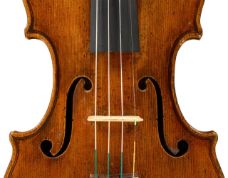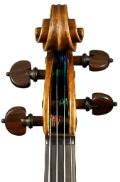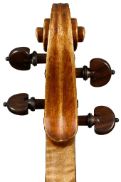Violin, Andrea Guarneri, Cremona, mid-17th century
Druckzettel: „Andreas Guarnerius fecit Cremone sub titulo / Sanctæ Teresiæ 1656“ (1656 handschriftlich und kaum leserlich)Records show that Andrea Guarneri lived in Nicolò Amati’s household from 1641. It was common at the time for apprentices and sometimes even journeymen to live in their master’s household. Guarneri established a household of his own only after getting married in 1652. His teacher’s influence remains evident in the instruments he fashioned in his own workshop. The proportions of this violin correspond to the Amati model, with the exception of marginal changes to the curves of the upper and lower bouts. The f-holes are also different; they are positioned very close to one another. The two-piece belly has medium-wide annual rings that quickly become broader toward the edge, while the two-piece back displays pronounced, somewhat irregular flames in a V shape. The structure of the rib wood matches that of the back. Above all the belly is highly arched. The f-holes appear quite delicate and have large eyes. The violin has a striking purfling with broad black strips. Guarneri’s personal touch shows above all in the dainty-looking scroll with its clearly visible toolmarks. Much of the original reddish-yellow original varnish is still visible, especially on the back.











